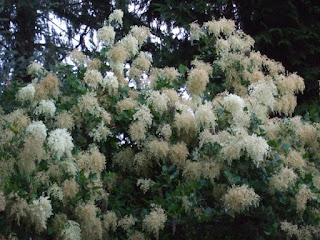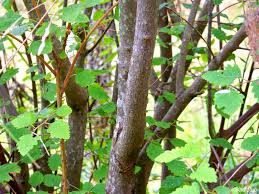Thursday, September 29, 2016
OCEANSPRAY (Not the Cranberry Juice)
OCEANSPRAY –Holodiscus Discolor, Holodiscus Boursieri, Holodiscus Microphyllus, Sericotheca Discolor, Spiraea Discolor, Schizonotus Discolor
Also known as: Creambush, Ironwood, Arrow-Wood, Rock Spiraea, Mountain Spray, Hardhack, etc.
Parts used: seeds, flowers, leaves, stems and bark
Systems/organs affected: skin, gastrointestinal, bowel, immune, blood, DNA, respiratory
Properties: antiviral, anti-fungal, antibacterial, anti-diarrhea, antioxidant, cyto-toxic (a substance that has a toxic effect on certain cells), prophylactic, chemo-preventative (an agent that inhibits the development of invasive cancer by either blocking DNA damage or by stopping and/or reversing the progression of malignant cells).
OCEANSPRAY is a member of the Rosaceae family. It is a native of the Pacific Northwest but can now be found from British Columbia to California and as far east as Montana. It is a deciduous plant with arching branches, lobed, ovate leaves and creamy colored blossoms that are found in feathery clusters amongst the branches. The flowers kind of resemble an ocean wave as it hits a rock and sprays the surroundings. It blooms from late May to September (or later in some places) and the blooms turn a fawn color near the end. The flowers have a light sugary scent and produce a HUGE amount of pollen (they are considered an essential part of the environmental spectrum, often one of the first plants to grow in burned or logged areas). It can get up to 20 feet tall (depending on location) and does well on dry, rocky slopes but adapts to many environments. It provides food for moths and butterflies who seem to love this plant. In less productive months it also provides food for larger animals that have problems finding alternative sources of food such as elk, deer and snowshoe rabbits. It provides a home for nesting bushtits and gives cover to grouse, non-game birds, deer, elk and other mammals. The seeds of this plant are extremely costly (roughly $210 per pound) and not
easily propagated (only about 10% ever take). It grows best from branch cuttings or root sprouting.
The oceanspray plant is called the “Romance Herb” of the Northwest claiming that the flowers are as fragile as love. The story goes that a young woman was set to marry a man she did not love and so she ran away on the day of the wedding to the forest. As she ran her wedding veil was torn and left across branches of this plant for her true love to find, only he never comes, leaving her to mourn her lost love through the ages. SIGH…
The first mention of this plant is actually done by Meriwether Lewis while he was staying at Camp Chopunnish in Idaho County, Idaho. He harvested the plant for his scientific collection. However, the Native Americans had been using it for a very long time for a host of things, both medicinal and practical. The Okanagan-Coleville use the powdered bark mixed with Vaseline for burns and/or skin issues. The Lumi used the blossoms for diarrhea, the leaves they used topically in a poultice for sore feet as well as sore lips. The inner bark was used in an infusion as an eyewash. The Sanpoil used the powdered leaves for sores. The Makah used a bark decoction as a tonic for convalescents and athletes. The Navajo used a decoction of the leaves for the flu. The Chehalis and Squaxin used the seeds to purify the blood and help with such things as chicken pox, smallpox and the black measles (also known as hemorrhagic measles). The Oregon settlers would pulverize the bark and leaves to use for scrapes and burns.
The native tribes also used the plant for a host of more practical items. The Makah and Lumi both used it to make duck spears and tongs for roasting. The Saanich used it to make BBQ sticks, utensils and as digging sticks for harvesting camas bulbs. The Okanagan-Colville tribe would use it to make bows, arrows, teepee pins, baby cradle covers and spear heads for fishing. The Salish would use it to make skewers for clams and knitting needles to make clothing. The Karok used it to make sticks for games they would play. The various tribes also used this wood to make bow and drills, harpoons and hooks for fish and other things. The pioneers used it to make pegs to use in the place of nails. The Comox Indians believed that when the plant would bloom it was time to go dig clams (which they used sticks from this plant to do).
The flower essence of this herb is used for those who cover up their grief and go about their business as if everything is okay. These people often will experience eczema, psoriasis or some kind of respiratory disorder. The essence helps them to release this deeply seeded grief so they can move forward and heal.
As recently as 2001 oceanspray was studied and found to have a host of very beneficial components including resveratrol, taraxasterol, beta-sitosterol, etc. All are antioxidants and known to protect and detoxify the system.
While this plant is relatively new to the modern markets, it has been used prolifically by ancient ones. I was unable to find ANY information regarding medication interactions with this herb. Nor was I able to find any formulas using this plant. I do know I have it in my yard in several places so that makes me a VERY happy person! As always, consult a physician before starting any herbal product or regimen.
As is customary with my posts I am including a few links....enjoy! Stay healthy and strong!
https://www.amazon.com/OCEANSPRAY-Creambush-Mountain-Holodiscus-Flower/dp/B01HSZWESU/ref=sr_1_fkmr0_1?ie=UTF8&qid=1475181020&sr=8-1-fkmr0&keywords=holodiscus+discolor
https://www.amazon.com/Rare-Antique-Botanical-Print-HOLODISCUS-ARGENTEUS-SPIRAEA-Turpin-Massard-1816/dp/B00F0MO3Q0/ref=sr_1_fkmr0_2?ie=UTF8&qid=1475181020&sr=8-2-fkmr0&keywords=holodiscus+discolor
http://portlandnursery.com/plants/natives/holodiscus.shtml
https://www.etsy.com/listing/196091160/holodiscus-discolor-oceanspray-ironwood?utm_source=google&utm_medium=cpc&utm_campaign=shopping_us_b-jewelry-necklaces-pendants&utm_custom1=9e514deb-d774-440a-915b-bdb5e4882ca1&gclid=CjwKEAjw97K_BRCwmNTK26iM-hMSJABrkNtbMIZ6FLffm7uvPf5JExT2x52uvxc6STq0-exI3KzbXRoCry7w_wcB
Subscribe to:
Post Comments (Atom)









No comments:
Post a Comment